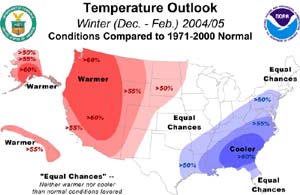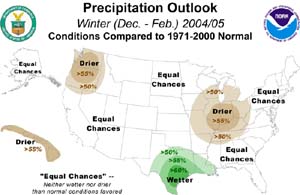| NOAA Magazine || NOAA Home Page || Previous Story |
NOAA U.S. WINTER OUTLOOK UPDATE
 Oct.
21, 2004 ó NOAA today updated its
U.S.
Winter Outlook for December 2004 through February 2005, which continues
to call for warmer-than-normal conditions in the West and Alaska, and
cooler-than-normal conditions in the South and in sections of the mid-Atlantic
coast states. (Click NOAA image for larger view of forecast
winter temperatures for the USA. Click
here for high resolution version, which is a large file. Please
credit “NOAA.)
Oct.
21, 2004 ó NOAA today updated its
U.S.
Winter Outlook for December 2004 through February 2005, which continues
to call for warmer-than-normal conditions in the West and Alaska, and
cooler-than-normal conditions in the South and in sections of the mid-Atlantic
coast states. (Click NOAA image for larger view of forecast
winter temperatures for the USA. Click
here for high resolution version, which is a large file. Please
credit “NOAA.)
For precipitation, NOAA's Outlook calls for drier-than-average conditions in the Pacific Northwest and Ohio Valley and wetter-than-average conditions over parts of the South. In Hawaii, temperatures are expected to be above average with precipitation below average. Elsewhere, there are equal chances of above, below and normal temperatures.
 Currently,
NOAA is monitoring a weak El
Niño in the tropical Pacific, which is expected to continue
into early 2005. However, NOAA scientists predict this El Niño
will remain much weaker than the 1997-1998 El Niño event. (Click
NOAA image for larger view of forecast winter precipitation for the
USA. Click here
for high resolution version, which is a large file. Please credit “NOAA.)
Currently,
NOAA is monitoring a weak El
Niño in the tropical Pacific, which is expected to continue
into early 2005. However, NOAA scientists predict this El Niño
will remain much weaker than the 1997-1998 El Niño event. (Click
NOAA image for larger view of forecast winter precipitation for the
USA. Click here
for high resolution version, which is a large file. Please credit “NOAA.)
"El Niño wintertime impacts over the United States vary considerably depending on the character of the warming in the tropical Pacific," said Vernon Kousky, NOAA's lead El Niño/Southern Oscillation forecaster. "While we are carefully monitoring this current El Niño episode, we are expecting other climate patterns to play an equally important role in this winter's weather."
NOAA scientists say the leading climate patterns expected to impact this winter's weather are long-term climate trends and features such as the El Niño/Southern Oscillation (ENSO) and the Pacific/North American pattern (PNA), which influence the jet stream and the track storms take across the eastern Pacific and North America. In addition, the North Atlantic Oscillation (NAO) can affect winter weather in the Northeast by altering the jet stream over the North Atlantic and adjacent areas. “These climate patterns are the physical basis for this season's winter outlook and updates like the one presented today,” said Wayne Higgins, principal climate scientist at the NOAA Climate Prediction Center.
NOAA is dedicated to enhancing economic security and national safety through the prediction and research of weather and climate-related events and providing environmental stewardship of the nationís coastal and marine resources. NOAA is part of the U.S. Department of Commerce.
Relevant Web Sites
Climate Factors Helping to Shape Winter
2004-2005
NOAA Climate Prediction Center
NOAA
Drought Information Center
El
Niño/Southern Oscillation (ENSO) Diagnostic Discussion
Weekly
El Niño/Southern Oscillation (ENSO) Update
Most
Recent 2 Months Sea Surface Temperature Anomaly Animation
El
Niño and La Niña-related Winter Features over North America
Sea
Surface Temperature Outlook
ENSO
Impacts by Region
NOAA Storm Watch —
Get the latest severe weather information across the USA
Media
Contact:
Carmeyia
Gillis, NOAA Climate Prediction
Center, (301) 763-8000 ext. 7163